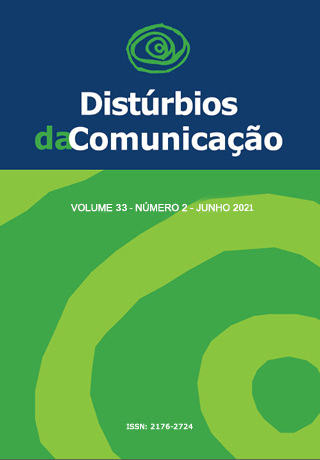Therapeutic itinerary of hearing impaired patients
DOI:
https://doi.org/10.23925/2176-2724.2021v33i2p279-286Keywords:
Hearing Loss, Health Services Accessibility, Public HealthAbstract
Introduction: The actions of the hearing health service are performed by basic, middle and high complexity care in a hierarchical manner, organized to facilitate diagnosis, recovery and rehabilitation. Knowing the route taken by the user can influence the solution adopted and identify difficulties to early diagnosis. Objective: To analyze the profile and therapeutic itinerary of patients diagnosed with hearing impairment in a Microregional Hearing Health Service in Minas Gerais. Method: Retrospective descriptive analysis of the medical records data from the hearing service Sete Lagoas, of 189 subjects who received hearing aids by the Unified Health Service between the years 2018/2019 at the reference service on Medium Complexity in the Microregion. There are a greater number of users over the age of 60 in Sete Lagoas and also in the micro-region. The classification as to sex shows a predominance of women in the entire service area and mainly in the city of Sete Lagoas. Results: The analysis of the itinerary shows that the time between arrival at the hearing health service and the stages of pre-mold, test and delivery of the hearing aid is shorter for children than for adults and the elderly. A higher number of users over 60 years of age is observed in Sete Lagoas and also in the microregion. Conclusion: The route taken by the patients interferes with the use of the hearing aid and a proper adaptation due to the waiting time and distance covered. Adults and elderly have a longer itinerary in relation to children.
Downloads
References
Ministério da Saúde. Portaria nº 2.073, de 28 de setembro de 2004. Brasília: Ministério da Saúde; out 2004.
Ministério da Saúde. Saúde auditiva. Portarias de saúde auditiva. Brasília: Ministério da Saúde; out 2004.
Teixeira CF. Estudo avaliativo da política de atenção à saúde auditiva: estudo de caso em Pernambuco [tese]. Recife: Centro de Pesquisa Aggeu Magalhães, Fundação Oswaldo Cruz; 2007.
Maciel FJ, Januário GC, Henriques CMA, Esteves CC, Silva MA, Carvalho SAS, Lemos SMA ACR. Indicadores de saúde auditiva em Minas Gerais – um estudo por macrorregião. 2013; 18(4): 275-84.
Cook JA, Hawkins DB. Outcome measurement for patients receiving hearing aid services. Laryngoscope. 2007; 117(4): 610-3.
Tamaki EM, Tanaka OY, Felisberto E, Alves CKA, Drumond Junior M, Bezerra LCA, et al. Metodologia de construção de um painel de indicadores para o monitoramento e avaliação da gestão do SUS. Ciênc Saúde Colet. 2012; 17(4): 839-494.
Brustolin AFF. Therapeutic itinerary of elderly cancer survivors. Acta paul. enferm. 2017; 30(1): -59.
Pinho PA, Pereira PPG. Therapeutic itineraries: paths crossed in the search for care. Interface - Comunic, Saude, Educ. 2012; 16(41): 435-47.
Aquino RCA, Lima MLLT, Silva VL, Alencar FL, Rodrigues M. Therapeutic itinerary and access to health services in cases oral cancer deaths. Rev. CEFAC. 2018 Set-Out; 20(5): 595-603.
Instituto Brasileiro de Geografia e Estatística (página da internet), Diretoria de Pesquisas, Coordenação de População e Indicadores Sociais, Estimativas da população residente com data de referência 01 de julho de 2019. Disponível em: https://www.ibge.gov.br/institucional.
Rota Mapas. (página da internet). Acesso em 06 de maio de 2020. Disponível em: https://www.rotamapas.com.br/minas-gerais. Brasil
Gresele, ADP, Lessa AH, Alves LC, Torres EMO, Vaucher AVA, Moraes AB, Costa MJ. Levantamento e análise de dados de pacientes atendidos em um programa de concessão de aparelhos de amplificação sonora individual. CoDAS 2013; 25(3): 195-201.
Chien W, Lin FR. Prevalence of Hearing Aid Use among Older Adults in the United States. Arch Intern Med. 2012; 172(3): 292–3.
Correia RO, Pinheiro CCD, Paiva FCG, Gomes-Neto PS, Rodrigues TP, Mendonça ATB, Freitas MR. Reabilitação auditiva por aparelhos de amplificação sonora individual (AASI): perfil epidemiológico de pacientes adaptados em um hospital terciário em 5 anos. Rev Med UFC. 2017; 57(2): 26-30.
Roth TN, Hanebuth D, Probst R. Prevalence of age-related hearing loss in Europe: a review. Eur Arch Otorhinolaryngol. 2011; 268(8): 1101-7.
Espmark AK, Rosenhall U, Erlandsson S, Steen B. The two faces of presbyacusis: hearing impairment and psychosocial consequences. Int J Audiol. 2002; 41(2): 125-35.
Jardim, D S; Maciel, F J; Lemos, S M A. Perfil epidemiológico de uma população com deficiência auditiva. Rev. CEFAC. 2016 Maio-Jun; 18(3): 746-57.
Ribas A; Rosa M; Dante G; Martins-Basseto, J. SOS Prótese Auditiva – relato de um estudo de caso realizado na Clínica de Fonoaudiologia da UTP. Tuiuti: Ciência e Cultura, n. 38, p. 09-18, Curitiba, 2006.
Popelka, M. M., Cruickshanks, K. J., Wiley, T. L., Tweed, T. S., Klein, B. E. K., & Klein, R. (1998). Low prevalence of hearing aid use among older adults with hearing loss: The epidemiology of hearing loss study. Journal of the American Geriatrics Society, 46(9), 1075–8.
Freitas CD, Costa MJ. Processo de adaptação de próteses auditivas em usuários atendidos em uma instituição pública federal - parte I: resultados e implicações com o uso da amplificação. Rev Bras Otorrinolaringol 2007; 73(6): 744-51.
Abby McCormack & Heather Fortnum (2013) Why do people fitted with hearing aids not wear them. Int J Audiol. 52: 5, 360-8.
Vera-Genevey H, Lebogang R. Rehabilitation for disabling hearing loss: evaluating the need relative to provision of hearing aids in the public health care system, Disability and Rehabilitation, 41: 22, 2704-7.
Downloads
Published
Issue
Section
License
Copyright (c) 2021 Kenia Isabella de Souza, Camila Ferreira Ambrosio, Teresa Maria Momensohn Santos

This work is licensed under a Creative Commons Attribution 4.0 International License.









